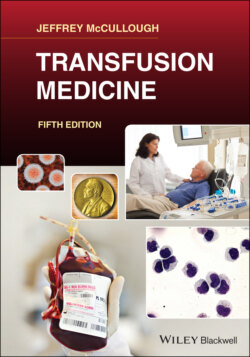Читать книгу Transfusion Medicine - Jeffrey McCullough - Страница 154
Fresh frozen plasma
ОглавлениеThree pathogen‐inactivated FFP products are in use in Europe. Methylene blue can be added to plasma, and subsequent exposure to visible light inactivates most viruses and bacteria [129, 130]. The plasma can then be frozen as an FFP product. Three other pathogen inactivation methods are used for both plasma and platelets [118–122]. One uses a psoralen compound and ultraviolet A (UV‐A) light [131], one uses riboflavin and ultraviolet B (UV‐B) light [132], and a third method uses ultraviolet C (UV‐C) light [133]. The psoralen compound followed by UV light results in intercalation into DNA or RNA with cross‐links. Riboflavin damages DNA upon exposure to UV light. Both methods prevent nucleic acid replication. Thus, contaminating pathogens are inactivated, but platelets are not damaged. Extensive toxicity, mutagenicity, and pharmacologic studies have given satisfactory results. The psoralen product has satisfactory coagulation factor levels and provides posttransfusion increases in coagulation factors similar to ordinary FFP [131]. The riboflavin‐treated FFP also has satisfactory levels of coagulation factors [132]. Because these products are relatively new, there is little clinical experience reported, but the psoralen product is effective in patients with bleeding due to liver disease [134] and for replacement in patients with thrombotic thrombocytopenic purpura [135]. Plasma treated with the psoralen method is now FDA approved for use in the United States.
Table 5.11 Coagulation factor and inhibitor levels in 12 lots of Octaplas.
Source: Adapted from Solheim BG, Hellstern P. Composition, efficacy, and safety of S/D‐treated plasma. Transfusion 2003; 43:1176–1178.
| Measure | Reference range | Octaplas (n = 12)a |
| PT (s) | 12.5–16.1 | 13.3 (12.9–13.8) |
| aPTT (s) | 28–40 | 35 (34–37) |
| Fibrinogen (g/L) | 1.45–3.85 | 2.5 (2.4–2.6) |
| Prothrombin | 65–154 | 83 (79–86) |
| Factor V (U/100 mL) | 54–145 | 78 (75–84) |
| Factor VII (U/100 mL) | 62–165 | 108 (90–117) |
| Factor X (U/100 mL) | 68–148 | 78 (75–80) |
| Factor VIIa (mU/mL) | 25–170 | 166 (134–209) |
| Protein C activity (U/100 mL) | 58–164 | 85 (81–87) |
| Protein S activity (U/100 mL) | 56–168 | 64 (55–71) |
| PI (U/100 mL) | 72–132 | 23 (20–27) |
| Plasminogen (U/100 mL) | 68–144 | 96 (92–101) |
| Citrate (mM) | 17.5 (14.2–20.9) |
aPTT, activated partial thromboplastin time; PT, prothrombin time.
a Data are reported as mean (range).
